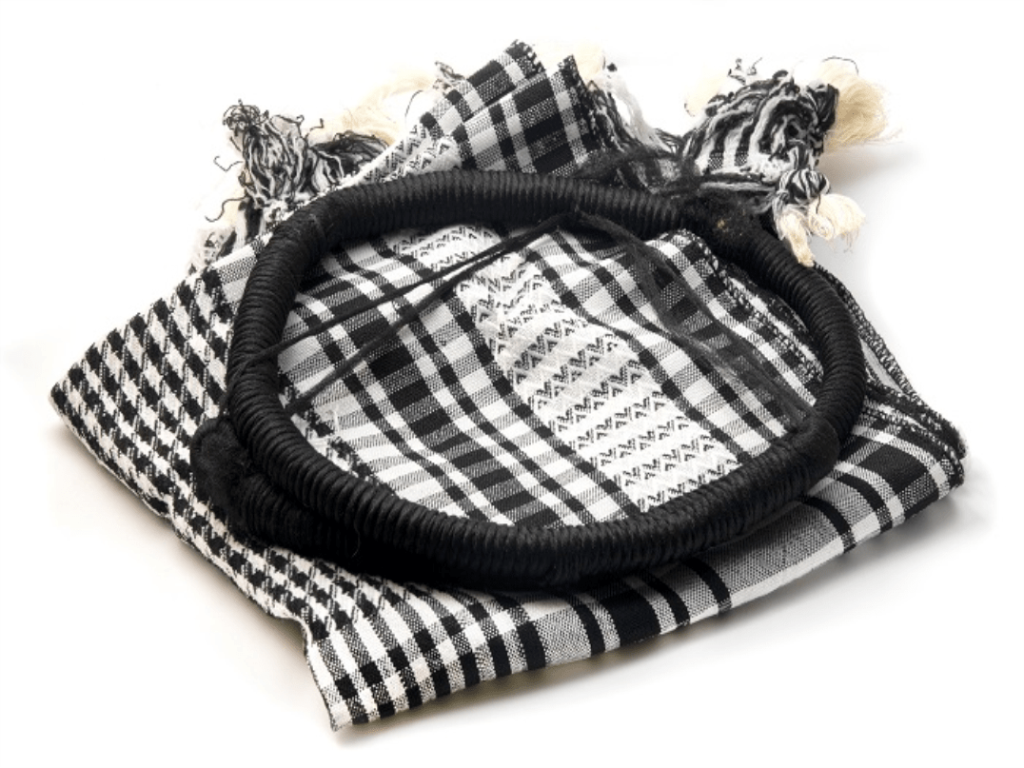Have you ever seen an Arab man wearing a piece of cloth on his head and wondered about its name or meaning? This traditional headwear is an important part of Arab culture, with different names and types. In this article, we’ll learn about the most famous Arab headdresses, how men wear them, and their different meanings.
What is the Arab Headdress?
Men in the Middle East wear headdresses called the Ghutrah, Shemagh, and Keffiyeh. While they primarily use them to protect their heads and faces from the sun, sand, and cold, these pieces have also become important cultural symbols that express identity.
Varieties and Variations
The world of Arab headdresses is rich with variety, with each style telling a story about its origin, people, and purpose. While they all offer protection from the harsh desert sun, their unique designs and colors carry distinct cultural and political meanings.
The Keffiyeh (كوفية)
The Keffiyeh is the most globally recognized Arab headdress, famous for its checkered pattern. It is an iconic symbol of resilience, land, and identity.
- Palestinian Keffiyeh: The classic black-and-white keffiyeh is a powerful symbol of Palestinian nationalism and solidarity. The pattern isn’t just decorative; it’s steeped in symbolism. The bold black lines, for example, represent ancient trade routes and fishing nets, while the olive leaves symbolize resilience and perseverance. The association with Palestinian leaders like Yasser Arafat gave this keffiyeh international prominence.
- Other Keffiyeh Variations: While the Palestinian keffiyeh is the most famous, other variations exist. For example, some keffiyehs feature different colors or more intricate patterns, which often denote tribal affiliations or regional identities.
The Shemagh (شماغ)
The Shemagh is a type of keffiyeh, but it is typically known for its bolder, often more geometric patterns.
- Jordanian Shemagh: The red-and-white shemagh is a prominent symbol of Jordanian national identity. Jordanians wear it widely, from military members to Bedouin tribes, and it is a key part of the country’s national dress. Many see the red color in the pattern as a tribute to the country’s national flag and heritage.
- Saudi Shemagh: In Saudi Arabia, the red-and-white shemagh is also very popular. Men often wear it with an agal and a white thobe. It is a symbol of dignity and national pride, and its heavy material makes it suitable for winter.
The Ghutrah (غُترة)
The Ghutrah is often a plain, un-patterned headdress, most famously a bright white.
- White Ghutrah: The white ghutrah symbolizes purity, dignity, and formality. It is the most common headdress in the Gulf countries, especially during the hot summer months, as its light color helps reflect the sun’s heat. You will often see men wear it on official occasions and for daily use in Saudi Arabia, the UAE, and Qatar.
- Omani Mussar: Omanis have a unique style of headdress. They often wear a special type of mussar (a patterned turban-style wrap) and typically do not use an agal to hold it in place. Instead, they neatly wrap and fold it.
How Keffiyehs Are Worn
Men wear the Keffiyeh and Shemagh in different ways. The most common way involves wrapping it around the head and securing it with a black cord called an Agal. The Agal is a rope-like piece men place over the headdress to hold it in place. Men can also wear the headdress as a scarf around the neck or over the shoulders, especially in places that don’t require traditional attire.
A Small Comparison Guide
| Feature | Keffiyeh | Shemagh | Ghutrah |
|---|---|---|---|
| Common Color | Black and white | Red and white | White (sometimes with light patterns) |
| Region | The Levant (Palestine, Jordan) | Jordan and Gulf countries | Gulf countries (Saudi Arabia, UAE) |
| Symbolism | Symbol of Palestinian identity and resistance | Symbol of Jordanian national identity | Symbol of dignity and purity |
| Material | Often light cotton | Often cotton or wool (heavier) | Light cotton |
The Agal: What Is It?
The Agal is a black cord that men wear over the headdress to secure it on the head. It’s not just a tool for securing the headwear but is also an essential part of the traditional attire.
The Arab Headdress in Global Culture
In recent years, the Arab headdress, especially the Keffiyeh, has become more than just a cultural symbol. It has transformed into a fashion trend. Many non-Arabs in the West wear it as a scarf or to show solidarity with a particular cause. This sometimes sparks a debate about cultural appropriation, as some believe people should wear this headdress with an understanding and respect for its original meaning, and not just for fashion.
Conclusion
Learning about these cultural symbols is a great way to deepen your understanding of the Arabic language and its people. If you’re ready to take the next step and continue your journey, download the Kaleela App today. With Kaleela, you can learn Arabic in a fun and effective way and discover more fascinating cultural topics like this one.



